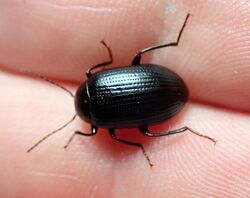Biology:Amarygmus
| Amarygmus | |
|---|---|

| |
| Amarygmus watti, New Zealand | |
| Scientific classification | |
| Domain: | Eukaryota |
| Kingdom: | Animalia |
| Phylum: | Arthropoda |
| Class: | Insecta |
| Order: | Coleoptera |
| Infraorder: | Cucujiformia |
| Family: | Tenebrionidae |
| Tribe: | Amarygmini |
| Genus: | Amarygmus Dalman, 1823 |
Amarygmus is a genus of darkling beetles (family Tenebrionidae). It is in the tribe Amarygmini and is the oldest genus of the tribe.[1] The genus occurs in Australia (mainly in the north), New Guinea, Hawaii,[2] Africa and Eurasia.[3]
Description
Amarygmus is a variable genus. Some descriptions of adults are given below:
- In species found in Borneo, the apices of the mandibles are bifid and not truncate. The femora of the legs are usually enlarged in the middle or at the apical third. There are hairs usually on the clypeus, legs, antennomeres and, frequently, as a sexual character on the underside of males. Traits found in related genera, such as long, erect hairs on pronotum and elytra (found in Bunamarygmus) are absent.[1]
- In species found in Australia, the body is usually oval (rarely subparallel), convex and glabrous. Body length ranges from 6 to 15 mm. The colour is usually fuscous (dark) or black, sometimes metallic green or purple. The apices of the mandibles are bifid. The elytra are usually distinctly striate but sometimes only punctate. The tarsal vestiture is fulvous.[3]
Larvae and pupae of A. morio have been described:
- The larva is elongate and cylindrical (similar to wireworms), with a shiny, strongly chitinised surface that is mostly yellow-brown. Most areas of the body have a few long, slender setae. The ninth abdominal tergum has a deep dorsal concavity with four small blunt teeth posteriorly.[2]
- The pupa has a pronotum similar in shape to the adult pronotum. Each lateral border of the pronotum has approximately 25 short tubercles. The abdominal terga are broad and most are equipped with lateral processes. The ninth tergum has a pair of long, acute, diverging urogomphi.[2]
Ecology
Larvae of some species feed on lichens at night.[3]
Larvae of A. morio have been collected from the trunk of a decayed mango tree.[2]
Amarygmus tristis is associated with old woody plants, including Acacia mearnsii, Eucalyptus spp., Solanum mauritianum and Virgilia capensis. During the day, it occurs in holes or under bark. It is rather common in gardens.[4]
Gallery
References
- ↑ Jump up to: 1.0 1.1 Bremer, H. J. (2010). "Revision of the genus Amarygmus Dalman and related genera. LVI. The Amarygmini of Borneo (Coleoptera: Tenebrionidae), part I". Stuttgarter Beiträge zur Naturkunde A 3: 139–256. https://citeseerx.ist.psu.edu/document?repid=rep1&type=pdf&doi=bbab536300623d7802dc2ef56c650cc362144cc9.
- ↑ Jump up to: 2.0 2.1 2.2 2.3 Spilman, T. J. (1966). "Larva and Pupa of Amarygmus morio from Hawaii (Coleoptera: Tenebrionidae)". Proceedings of the Hawaiian Entomological Society XIX: 297–301. https://scholarspace.manoa.hawaii.edu/server/api/core/bitstreams/8a271511-34f7-4599-982d-fd1045bc9ca2/content.
- ↑ Jump up to: 3.0 3.1 3.2 Matthews, E. G.; Lawrence, J. F. (2019). "36. Tenebrionidae Latreille, 1802". in Ślipiński, A.. Australian Beetles. Clayton South, VIC, Australia: CSIRO Publishing. ISBN 978-0-643-09728-5. OCLC 1238131004. https://www.worldcat.org/oclc/1238131004.
- ↑ Kuschel, G. (1990). Beetles in a suburban environment: a New Zealand case study: the identity and status of Coleoptera in the natural and modified habitats of Lynfield, Auckland (1974-1989). DSIR. ISBN 0-477-02596-X. OCLC 28282817. https://www.cerambycoidea.com/titles/kuschel1990.pdf.
Further reading
- Grimm, R. (1 December 2018) "New and little known species of Tenebrionidae (Coleoptera) from Borneo (8)". Integrative Systematics: Stuttgart Contributions to Natural History, 1(1), 59-70
Wikidata ☰ Q18116384 entry
 |









